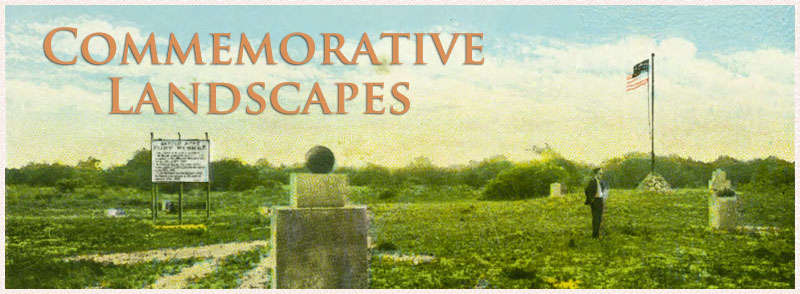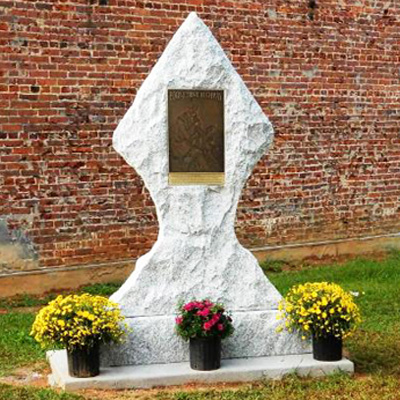
Boone Trail Highway Marker (#104), Elkin
The Elkin marker is seven-foot high knapped granite arrowhead marker made from Mt. Airy granite. A bronze tablet cast in the manner of the original Boone Trail Highway markers is inset into the granite. This reproduction is from a Style-3 tablet primarily used between 1927 and 1938 and is distinguished by the BOONE TRAIL HIGHWAY caption being slightly curved. It holds an image in relief taken from Alonzo Chapel’s 1861 illustration of Boone and his hunting dog. This reproduction does not have the wording at the bottom that it contains metal from the Battleship Maine as an original would have had and the original would have been made of steel.
This Boone Highway marker was numbered 104 by Everett G. Marshall. His interest and research of the markers led to the book, Rich Man, Daniel Boone. The numbering system was simply the order in which he found or became aware of a marker. The first mention of an Elkin marker is from March 1918 that plans were in place to erect one on the public square. As of 1921 it was still not in place and no record was found it was ever erected prior to the reproduction being placed.
BOONE TRAIL HIGHWAY
September 10, 2013
36.244700 , -80.851000
View in Geobrowse
"J. Hampton Rich," from the "Images of North Carolina" digital collection, Davie County Public Library, (accessed January 21, 2015) Link
Jones, H.G. “Rich, Joseph Hampton,” NCPedia.org, (accessed March 22, 1917) Link
Jones, Randell. “Markers for Boone’s Trail Have Rich History,” Journal West (Winston-Salem, NC) November 26, 2013, (accessed March 13, 2017) Link
Marshall, Everett G. Rich Man: Daniel Boone (Dugspur, VA: Sugar Tree Enterprises, 2003)
Stanford, Raney. “Shades of Dan’l Boone! Says J.H. Rich,” The Daily Tarheel (Chapel Hill, NC), February 8, 1948
“Boone Trail,” The Elkin Tribune (Elkin, NC), March 7, 1918
“Daniel Boone Trail Marker to Be Unveiled September 10,” Elkin Valley Trails Association, September 8, 2013 (accessed March 28, 2017) Link
“Elkin Valley History and Nature Trail-Downtown on Hwy 21,” What’s Up In Elkin, NC, (accessed March 28, 2017) Link
“The Boone Tablet,” Winston Salem Journal (Winston-Salem, NC), May 17, 1916
Yes
Bronze, granite
Elkin Valley Trails Association
Everett G. Marshall whose interest and research of the markers led to the book, Rich Man: Daniel Boone was scheduled to unveil the marker and talk on the history of the Boone Highway markers.
J. Hampton Rich was a well-known figure in North Carolina’s “Good
Roads Movement” during the early 20th Century when public pressure
was used to force enhancements in the public highway system.
Attaining minor celebrity status he eventually extended his vision
beyond the borders of his home state. Using the legacy of Daniel
Boone as a hook, he first began to cross North Carolina and then the
United States drumming up support for commemorative highway markers.
Between 1917 and 1938 Rich was one of the most prolific commemorators
in the United States. He claimed responsibility for hundreds of
markers, some in places that had no connection to Boone at all like
Washington, D.C.; Boston, Massachusetts; Pike’s Peak, Colorado and at
the Golden Gate Bridge in San Francisco.
Rich was born in 1874 on land where the family of Daniel Boone may
have once lived. What is certain though is that Daniel Boone spent
many of his 21 years in North Carolina living in the area near
Mocksville in Davie County and surely Rich's lifelong passion for
Boone was influenced by his immersion in local lore surrounding the
famous frontiersman. Rich, who became a well-known newspaper man in
Winston-Salem, also developed a passion for good highways in the
state. Very likely taking a lead from a series of markers to Boone
placed by the Daughters of the American Revolution beginning in 1912,
Rich combined his two passions and came to the idea of capitalizing
on the pioneer’s fame as a way to encourage the building of better
roads.
In 1913, Rich established the Boone Trail Highway and Memorial
Association with the chief purpose to raise awareness of the need for
better roads in North Carolina. Rich also wanted to educate the
public about the history and heritage of the pioneer era and promote
patriotism. Beginning with the first documented marker, placed at
East Bend in Yadkin County in 1917,
Rich claimed to have placed about 360 tablets across the United
States by 1938. Of that number, (which came from Rich) less than 60
originals are still known to exist and it may be impossible to ever
know how many were actually incorporated into a highway memorial.
Although it is known that he sold some in the early years Riches
method of operation was typically to give a tablet, sometimes
multiple tablets, to a community with their promise to raise funds to
erect the highway marker. In some cases it was years before a marker
was ever constructed and it is almost certain that many markers were
never completed. The number of markers with documented proof of being
completed is less than 150. As more digitally preserved newspapers
from the period become available this number will likely increase.
Each tablet with the image of Daniel Boone includes wording that it
contains metal from the Battleship USS Maine sunk in Havana harbor in
1898 at the outset of the Spanish-American War. In 1916 with the help
of then Secretary of the Navy, Josephus Daniels, Rich had acquired
300 pounds of metal salvaged from the ship. It is questionable that
each plaque actually contained some of this metal. In a 1948 article
from “The Daily Tar Heel” Rich is quoted as saying “the first tablets
contained... metal from the battleship.” In addition to those
featuring Daniel Boone, Rich also created tablets featuring “Cherokee
Chief Sequoia” and a bison in an effort to mark ancient buffalo
traces used by Native American and then Colonial settlers from the
coast at Wilmington through the Great Smoky Mountains in the west.
Very few of these were produced and few examples remain. Other
efforts include tablets to Abraham Lincoln and possibly Davey
Crockett. Regardless of the image on the tablet, these are lumped
together under the heading of Boone Trail Highway and Memorial
Association markers. The best current resource is Rich Man: Daniel
Boone by Gary Marshall. His research efforts and the book’s
publication in 2003 generated interest in finding and protecting the
remaining markers.
Rich lived in Chapel Hill in the years prior to his death in 1949
where he could be seen “striding down the village streets wearing his
coon skin cap and maybe with his long rifle thrown over one arm.” He
was also "apt any day to walk into one of the University’s history
classes clad in his furry cap, and always on these occasions he is
introduced to the students by the professors as Daniel Boone."
The marker is located on N. Bridges Street near the intersection with W. Market Street, in Elkin, NC.
The marker stands on an empty lot with a lawn shaded by trees.
 Know anything else about this monument that isn't mentioned here? If you have additional information on
this or any other monument in our collection fill out the form at the Contact Us link in the footer. Thank you.
Know anything else about this monument that isn't mentioned here? If you have additional information on
this or any other monument in our collection fill out the form at the Contact Us link in the footer. Thank you.

